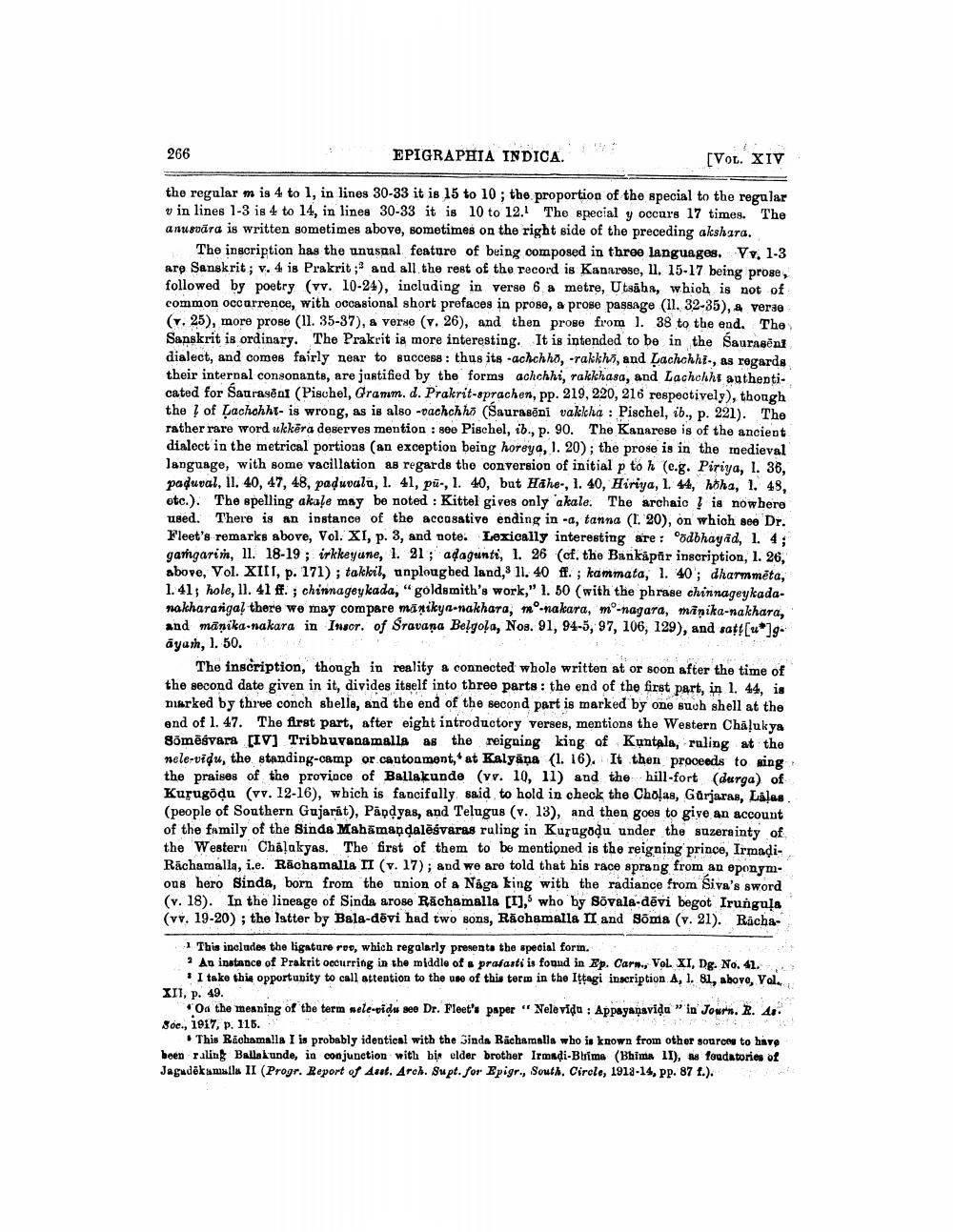________________
EPIGRAPHIA INDICA.
[VOL. XIV
the regular m is 4 to 1, in lines 30-33 it is 15 to 10; the proportion of the special to the regular v in lines 1-3 is 4 to 14, in lines 30-33 it is 10 to 12.1 The special y occurs 17 times. The anusvära is written sometimes above, sometimes on the right side of the preceding akshara.
266
The inscription has the unusual feature of being composed in three languages. Vv. 1-3 are Sanskrit; v. 4 is Prakrit ; and all the rest of the record is Kanarese, 11. 15-17 being prose, followed by poetry (vv. 10-24), including in verse 6 a metre, Utsäha, which is not of common occurrence, with occasional short prefaces in prose, a prose passage (11. 32-35), a verse (v. 25), more prose (11. 35-37), a verse (v. 26), and then prose from 1. 38 to the end. The Sanskrit is ordinary. The Prakrit is more interesting. It is intended to be in the Saurasent dialect, and comes fairly near to success: thus its achchho, -rakkhi, and Lachchhi-, as regards their internal consonants, are justified by the forms achchhi, rakkhasa, and Lachchht authenticated for Saurasent (Pischel, Gramm. d. Prakrit-sprachen, pp. 219, 220, 216 respectively), though the of Lachchht- is wrong, as is also vachchho (Sauraseni vakkha: Pischel, ib., p. 221). The rather rare word ukkera deserves mention: see Pischel, ib., p. 90. The Kanarese is of the ancient dialect in the metrical portions (an exception being horeya, 1. 20); the prose is in the medieval language, with some vacillation as regards the conversion of initial p to h (e.g. Piriya, 1. 36, paduval, 11. 40, 47, 48, paduvala, 1. 41, pu-, 1. 40, but Hähe-, 1. 40, Hiriya, 1. 44, hoha, 1. 48, etc.). The spelling akale may be noted: Kittel gives only akale. The archaic is nowhere used. There is an instance of the accusative ending in -a, tanna (1. 20), on which see Dr. Fleet's remarks above, Vol. XI, p. 3, and note. Lexically interesting are: odbhayad, 1. 4; gamgarim, 11. 18-19; irkkeyune, 1. 21; adagunti, 1. 26 (cf. the Bankapar inscription, 1. 26, above, Vol. XIII, p. 171); takkil, unploughed land,3 11. 40 ff.; kammata, 1. 40; dharmmēta, 1.41; hole, 11. 41 ff.; chinnageykada, "goldsmith's work," 1. 50 (with the phrase chinnageykadanakharangal there we may compare manikya-nakhara, me-nakara, m°-nagara, manika-nakhara, and manika-nakara in Insor. of Sravana Belgola, Nos. 91, 94-5, 97, 106, 129), and satt [u]gayam, 1. 50.
The inscription, though in reality a connected whole written at or soon after the time of the second date given in it, divides itself into three parts: the end of the first part, in 1. 44, is marked by three conch shells, and the end of the second part is marked by one such shell at the end of 1. 47. The first part, after eight introductory verses, mentions the Western Chalukya Sömēsvara [IV] Tribhuvanamalla as the reigning king of Kuntala, ruling at the nele-vidu, the standing-camp or cantonment, at Kalyana (1. 16). It then proceeds to sing the praises of the province of Ballakunde (vv. 10, 11) and the hill-fort (durga) of Kurugöḍu (vv. 12-16), which is fancifully said to hold in check the Cholas, Gurjaras, Lālas. (people of Southern Gujarat), Pandyas, and Telugus (v. 13), and then goes to give an account of the family of the Sinda Mahamandalesvaras ruling in Kurugodu under the suzerainty of the Western Chalukyas. The first of them to be mentioned is the reigning prince, IrmaḍiRachamalla, i.e. Rachamalla II (v. 17); and we are told that his race sprang from an eponymous hero Sinda, born from the union of a Naga king with the radiance from Siva's sword (v. 18). In the lineage of Sinda arose Rachamalla [I], who by Sovala-devi begot Irungula (vv. 19-20); the latter by Bala-devi had two sons, Rachamalla II and Soma (v. 21). Racha
1 This includes the ligature ree, which regularly presents the special form.
2 An instance of Prakrit occurring in the middle of a prasasti is found in Ep. Carm., Vol. XI, Dg. No. 41. I take this opportunity to call attention to the use of this term in the Iṭṭagi inscription A, 1. 81, above, Vol. XII, p. 49.
On the meaning of the term sele-vidu see Dr. Fleet's paper "Nelevidu : Appayanavida "in Journ. R. 48. Soc., 1917, p. 115.
This Rachamalla I is probably identical with the Jinda Rachamalla who is known from other sources to have been ruling Ballakunde, in conjunction with his elder brother Irmaḍi-Bhima (Bhima 11), as feudatories of Jagadēkamalla II (Progr. Report of Asst. Arch. Supt. for Epigr., South. Circle, 1918-14, pp. 87 1.).




